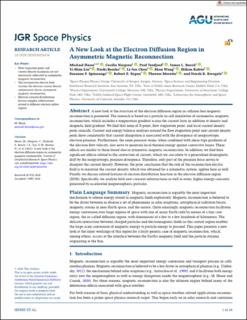| dc.contributor.author | Hesse, Michael | |
| dc.contributor.author | Norgren, Astrid Elisabet Cecilia | |
| dc.contributor.author | Tenfjord, Paul | |
| dc.contributor.author | James L., Burch | |
| dc.contributor.author | Liu, Yi‐Hsin | |
| dc.contributor.author | Bessho, Naoki | |
| dc.contributor.author | Wang, Shan | |
| dc.contributor.author | Kolstø, Håkon Midthun | |
| dc.contributor.author | Spinnangr, Susanne Flø | |
| dc.contributor.author | Ergun, Robert E | |
| dc.contributor.author | Moretto, Therese | |
| dc.contributor.author | Kwagala, Norah Kaggwa | |
| dc.date.accessioned | 2021-08-02T12:02:58Z | |
| dc.date.available | 2021-08-02T12:02:58Z | |
| dc.date.created | 2021-01-19T11:06:32Z | |
| dc.date.issued | 2021 | |
| dc.identifier.issn | 2169-9380 | |
| dc.identifier.uri | https://hdl.handle.net/11250/2765849 | |
| dc.description.abstract | A new look at the structure of the electron diffusion region in collision less magnetic reconnection is presented. The research is based on a particle-in-cell simulation of asymmetric magnetic reconnection, which includes a temperature gradient across the current layer in addition to density and magnetic field gradient. We find that none of X-point, flow stagnation point, and local current density peak coincide. Current and energy balance analyses around the flow stagnation point and current density peak show consistently that current dissipation is associated with the divergence of nongyrotropic electron pressure. Furthermore, the same pressure terms, when combined with shear-type gradients of the electron flow velocity, also serve to maintain local thermal energy against convective losses. These effects are similar to those found also in symmetric magnetic reconnection. In addition, we find here significant effects related to the convection of current, which we can relate to a generalized diamagnetic drift by the nongyrotropic pressure divergence. Therefore, only part of the pressure force serves to dissipate the current density. However, the prior conclusion that the role of the reconnection electric field is to maintain the current density, which was obtained for a symmetric system, applies here as well. Finally, we discuss related features of electron distribution function in the electron diffusion region (EDR). Specifically, we analyze both new crescent substructures as well as outer, higher energy crescents generated by accelerated magnetospheric particles. | en_US |
| dc.language.iso | eng | en_US |
| dc.publisher | AGU | en_US |
| dc.rights | Attribution-NonCommercial-NoDerivatives 4.0 Internasjonal | * |
| dc.rights.uri | http://creativecommons.org/licenses/by-nc-nd/4.0/deed.no | * |
| dc.title | A new Look at the Electron Diffusion Region in Asymmetric Magnetic Reconnection | en_US |
| dc.type | Journal article | en_US |
| dc.type | Peer reviewed | en_US |
| dc.description.version | publishedVersion | en_US |
| dc.rights.holder | Copyright 2020 The Authors | en_US |
| dc.source.articlenumber | e2020JA028456 | en_US |
| cristin.ispublished | true | |
| cristin.fulltext | original | |
| cristin.qualitycode | 2 | |
| dc.identifier.doi | 10.1029/2020JA028456 | |
| dc.identifier.cristin | 1874087 | |
| dc.source.journal | Journal of Geophysical Research (JGR): Space Physics | en_US |
| dc.identifier.citation | Journal of Geophysical Research (JGR): Space Physics. 2021, 126 (2), e2020JA028456 | en_US |
| dc.source.volume | 126 | en_US |
| dc.source.issue | 2 | en_US |

